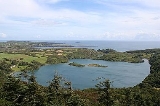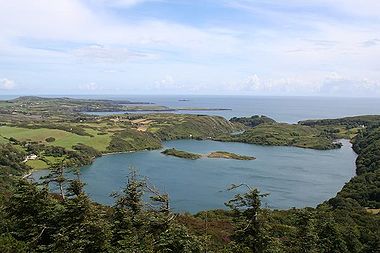
Lough Hyne
Encyclopedia

Marine (ocean)
Marine is an umbrella term. As an adjective it is usually applicable to things relating to the sea or ocean, such as marine biology, marine ecology and marine geology...
lake
Lake
A lake is a body of relatively still fresh or salt water of considerable size, localized in a basin, that is surrounded by land. Lakes are inland and not part of the ocean and therefore are distinct from lagoons, and are larger and deeper than ponds. Lakes can be contrasted with rivers or streams,...
in West Cork
West Cork
West Cork refers to a geographical area in south-west Ireland, lying within Ireland's largest county, County Cork. Traditionally a popular tourist destination, the area is seen as being distinct from the more populated northern or eastern parts of the county, as well as the more urban area of...
, Ireland
Ireland
Ireland is an island to the northwest of continental Europe. It is the third-largest island in Europe and the twentieth-largest island on Earth...
, about 5 km southwest of Skibbereen
Skibbereen
Skibbereen , is a town in County Cork, Ireland. It is the most southerly town in Ireland. It is located on the N71 national secondary road.The name "Skibbereen" means "little boat harbour." The River Ilen which runs through the town reaches the sea at Baltimore.-History:Prior to 1600 most of the...
. It was designated as Ireland's first Marine Nature Reserve
Marine Nature Reserve
Marine Nature Reserve is a British conservation designation officially awarded by the government to a marine reserve of national significance....
in 1981.
Lough Hyne was probably a freshwater
Freshwater
Fresh water is naturally occurring water on the Earth's surface in ice sheets, ice caps, glaciers, bogs, ponds, lakes, rivers and streams, and underground as groundwater in aquifers and underground streams. Fresh water is generally characterized by having low concentrations of dissolved salts and...
lake until about four millennia ago, when rising sea level
Sea level
Mean sea level is a measure of the average height of the ocean's surface ; used as a standard in reckoning land elevation...
s flooded it with saline
Saline water
Saline water is a general term for water that contains a significant concentration of dissolved salts . The concentration is usually expressed in parts per million of salt....
ocean water. The lake is now fed by tidal current
Ocean current
An ocean current is a continuous, directed movement of ocean water generated by the forces acting upon this mean flow, such as breaking waves, wind, Coriolis effect, cabbeling, temperature and salinity differences and tides caused by the gravitational pull of the Moon and the Sun...
s that rush in from the Atlantic through Barloge Creek. The stretch between the creek and the lake is known as "The Rapids." The lake's small size, only 0.8 km by 0.6 km, creates an unusual habitat of highly oxygenate
Oxygenate
Oxygenated chemical compounds contain oxygen as a part of their chemical structure. The term usually refers to oxygenated fuels. Oxygenates are usually employed as gasoline additives to reduce carbon monoxide that is created during the burning of the fuel....
d yet warm seawater
Seawater
Seawater is water from a sea or ocean. On average, seawater in the world's oceans has a salinity of about 3.5% . This means that every kilogram of seawater has approximately of dissolved salts . The average density of seawater at the ocean surface is 1.025 g/ml...
that sustains an enormous variety of plants and animals, many of which are not found anywhere else in Ireland. A wide variety of environment
Environment (biophysical)
The biophysical environment is the combined modeling of the physical environment and the biological life forms within the environment, and includes all variables, parameters as well as conditions and modes inside the Earth's biosphere. The biophysical environment can be divided into two categories:...
s such as cliff
Cliff
In geography and geology, a cliff is a significant vertical, or near vertical, rock exposure. Cliffs are formed as erosion landforms due to the processes of erosion and weathering that produce them. Cliffs are common on coasts, in mountainous areas, escarpments and along rivers. Cliffs are usually...
s, salt marsh
Salt marsh
A salt marsh is an environment in the upper coastal intertidal zone between land and salt water or brackish water, it is dominated by dense stands of halophytic plants such as herbs, grasses, or low shrubs. These plants are terrestrial in origin and are essential to the stability of the salt marsh...
, beach
Beach
A beach is a geological landform along the shoreline of an ocean, sea, lake or river. It usually consists of loose particles which are often composed of rock, such as sand, gravel, shingle, pebbles or cobblestones...
, and areas of greatly varying water movement add to the area's biodiversity
Biodiversity
Biodiversity is the degree of variation of life forms within a given ecosystem, biome, or an entire planet. Biodiversity is a measure of the health of ecosystems. Biodiversity is in part a function of climate. In terrestrial habitats, tropical regions are typically rich whereas polar regions...
. Some of the seawall
Seawall
A seawall is a form of coastal defence constructed where the sea, and associated coastal processes, impact directly upon the landforms of the coast. The purpose of a seawall is to protect areas of human habitation, conservation and leisure activities from the action of tides and waves...
s around the lake and the Rapids were built as relief work during the Great Hunger.
Scientific investigation of the area began in 1886 when Rev. William Spottswood Green
William Spotswood Green
William Spotswood Green was an Irish naturalist, specialized on marine biology.Born at Youghal and educated at Trinity College in Dublin, he was ordained a priest in 1873. Already before he left the services of the Church in 1890, he had worked on marine biology...
first recorded the presence of the purple sea urchin
Sea urchin
Sea urchins or urchins are small, spiny, globular animals which, with their close kin, such as sand dollars, constitute the class Echinoidea of the echinoderm phylum. They inhabit all oceans. Their shell, or "test", is round and spiny, typically from across. Common colors include black and dull...
Paracentrotus lividus. Prof. Louis Renouf resumed the scientific work in 1923 and promoted it as a 'biological station' and sustained studies have been carried out there since then. It is now one of the most-studied sites of its size in the world.Several laboratories were constructed near the shores of the lake, supporting ground-breaking ecological research under Prof. Jack Kitching and Dr John Ebling. A history of the marine research was published in 2011 'Lough Hyne: The Marine Researchers - in Pictures'.
The area is a tourist
Tourism
Tourism is travel for recreational, leisure or business purposes. The World Tourism Organization defines tourists as people "traveling to and staying in places outside their usual environment for not more than one consecutive year for leisure, business and other purposes".Tourism has become a...
attraction with a permanent exhibition on the lough and its importance at nearby Skibbereen Heritage Centre. The ruins of Saint Bridgit's Church are on the shores of the lake, as well as holy wells, Tobarín Súl and Skour Well, on the side of Knockomagh Hill. Castle Island is located in the center of the lake where the ruins of Cloghan Castle, once a fortress of the O'Driscoll
Driscoll (surname)
Driscoll is one derivation of the Irish Gaelic surname O'Driscoll. The Irish for O'Driscoll is Ó hEidirsceoil. It originates from Cork in the province of Munster where the O'Driscolls were, in ancient times, a powerful clan. They descend from an early High King of Ireland known as Lugaid mac Con...
clan
Clan
A clan is a group of people united by actual or perceived kinship and descent. Even if lineage details are unknown, clan members may be organized around a founding member or apical ancestor. The kinship-based bonds may be symbolical, whereby the clan shares a "stipulated" common ancestor that is a...
, are still visible. A nature trail up Knockomagh Hill offers superb views of the lough and the surrounding area.
Further reading
- Kearney, T. 2011. Lough Hyne: The Marine Researchers - in Pictures published by Skibbereen Heritage Centre in 2011.
- Norton, T.A. 2001. And in the beginning... the Pioneering Ecological work at Lough Hyne. in Marine Biodiversity in Ireland and Adjacent Waters. Proceedings of a Conference 26 - 27 April 2001. Ulster Museum publication no. 8.
- Holmes, J.M.C. 2008. Crustacean records from Lough Hyne (Ine), Co. Cork, Ireland: Part VIII. Bull. Ir. biogeog. Soc. No. 32: 62 - 68.

